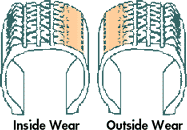Checking Tire Tread
There are two methods that can be used to check the depth of your tire tread. All passenger, light truck, and medium commercial tires have tread wear indicator bars molded into the tire tread. These bars are located in several locations around the tire at the bottoms of the tread grooves. When the tire is worn to the point that these bars become flush with the contact tread, it is time to replace the tire. A second method, although not as accurate as a depth gauge, would be the use of a US mint penny. A general rule of thumb, is if the top of President Lincoln's head can be seen, the tire should be replaced.

Common Signs and Indications of Improper Tire Wear
Always remember to consult an ASE certified shop or technician if you have any questions regarding issues with your vehicle. Many factors could be involved with improper tire wearing. Such factors could be, but not limited too; improper vehicle steering alignment, worn out linkages and mechanical parts, worn out bushings, out of spec ball joints and hub assemblies. It is always best to have the problem properly diagnosed to ensure complete and total safety of your vehicle.
Under Inflation: Common Sign - Wear On Outer Edges
If a tire looks like this, the most likely explanation is under inflation. This is a problem that can result in severely decreased treadlife through increase wear on the outer edges of the tire. As the tire rotates at highway speeds, this can lead to an increased build up of heat, and cause premature wearing of the rubber. In most occasions, decreased gas mileage can be attributed to this problem. The increase drag from the under inflated tire can cause the engine to work harder, thus decreasing fuel economy.

Over Inflation: Common Sign – Wear In Center of Tread Area
In the instance that a tire is over inflated, the center of the tread contact area can be over burdened with the weight of the vehicle. Over inflation can create a smaller contact area for the tread, thus increasing overall weighted load on the tire and causing an increase in wear on the center of the tire.
Scalloping and Saw Toothed Tread Wearing: Common Sign – Increased Tire Road Noise, Tire Edges Wearing Prematurely.
These symptoms are most commonly attributed to an improper vehicle alignment. Of the alignment itself, the most common cause is an out of spec Toe measurement. Although, an out of spec camber measurement can cause premature tire edge wearing. A common way to tell if this is happening would be to sweep your hand lightly side to side across the tread surface. The tread itself will feel as if it has some parts higher than others, and will not be a smooth transitions across the entire tire.


Keeping An Eye On Tread Depth
Proper tread depth is essential for traction performance in all conditions. If you start noticing a loss of traction is certain scenarios more than others, such as in wet conditions, the tread left on your tires may not be enough to create a suitable contact surface. The wear bars on your tire are generally set at 2/32nds of an inch, and should always be replaced once this is the tread depth measurement of your tire.
Tire Balancing
Have you noticed a strange vibration at certain speeds on the highway? It could be that one or more of your vehicles tires are out of balance. This can cause increase strain on vehicle steering and suspension components, increased tire wear and could also fatigue the vehicle's driver. Tires should always be balanced when being installed new, or being replaced after repairs. For larger diameter tires, it is a good idea to have the tires rebalanced at certain points during the tread life. This is due to the increased weight of a larger tire, but it is not a needed maintenance procedure.
Vehicle Alignment
Keeping a vehicle in proper alignment specifications will help preserve and extend the life of your vehicle. Many components can be affected by this issue, and it can also cause an owner to become disgruntled with that type of vehicle in the future. At minimum, it is best to have your vehicle aligned once a year, and everytime that the tires are replaced. Be mindful of the telltale signs of a bad alignment in the appearance of your tires, or if your vehicle drifts steadily to one side of the road. Be sure that the alignment is always done by a certified professional on top quality equipment.
Tire Rotation
A commonly overlooked part of general maintenance is the tire rotation. The general rule of thumb is to rotate your tires, front to rear – rear to front, every oil change. Commonly, this would result in every 3-4000 miles. This process allows the tires to wear evenly based on the vehicle load. Most vehicles being heavier in the front and lighter in the rear can cause the front tires to wear faster than the rear.
Repairing Tires
Any and all tire repairs should be made by a professional technician. If an emergency repair kit must be used, have the tire professionally repaired as soon as possible after. A proper tire repair will consist of a tire dismount and rubber patch, which will ensure a much higher safety level over tire plugs.











